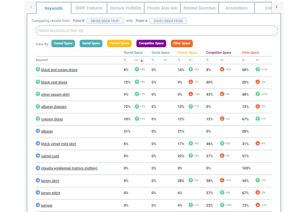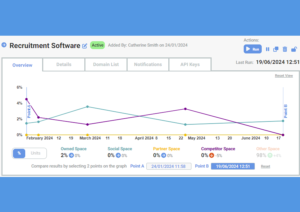Paid media and SEO teams don’t always work closely together on client accounts because they have different focuses.
PPC, paid social and other paid media is a performance channel. You create and publish ads that drive actions like clicks, sign-ups to a service or trial – or the ideal outcome, purchases.
SEO isn’t really a performance channel. It’s more of a brand and marketing channel. You build up awareness of your brand, product or service over time, with content that helps address the buyer intent for whichever search term the user is looking for.
With the difference in approach to these channels, you need to approach measuring them differently too.
PPC Measurement
PPC campaigns primarily aim for immediate results and conversions. These teams focus on driving traffic through paid ads, usually with the purpose of converting a visitor – to a free trial user or a paying customer.
PPC teams will typically measure:
- Click-Through Rate (CTR): Measures the percentage of users who click on the ad after seeing it.
- Conversion Rate: Tracks the percentage of users who complete a desired action (e.g., purchase, sign-up) after clicking the ad.
- Cost Per Click (CPC): Calculates the cost incurred for each click on the ad.
- Return on Ad Spend (ROAS): Evaluates the revenue generated per dollar spent on ads.
- Quality Score: Assesses the relevance and quality of keywords, ad copy, and landing pages.
PPC campaigns deliver quick results but require ongoing budget allocation and careful monitoring to avoid budget wastage. PPC teams make decisions and changes daily to ensure they’re getting the best return on their ads investment. It’s important that they continually improve on conversion rates, or maintain high performing ones. Any noticeable changes need to be investigated and addressed asap.
SEO Measurement
Conversely, SEO aims for long-term organic growth. SEO teams work on a longer time-frame often only seeing the impact of their work in months. SEO teams do a mix of tasks – looking at the website from a technical perspective, ensuring content is relevant and timely for the buyer journey, optimising internal links and disavowing bad links, among a multitude of other factors, all with the ultimate aim of ranking higher in search engine results, and dominating the space on page one.
SEO teams will typically measure:
- Organic Traffic: Measures the number of visitors from search engines.
- Keyword Rankings: Tracks how well specific keywords rank in SERPs.
- Backlinks: Evaluates the quantity and quality of external links pointing to the website.
- Bounce Rate: Indicates the percentage of users who leave the site without interacting further.
- Time on Page: Measures how long users spend on a page.
SEO teams often have a suite of tools at their disposal. Popular tools like SEMRush, Google Search Console but also niche tools like SERPsketch.
SEO efforts build sustainable traffic over time, aiming for long-term visibility, but require patience and consistent optimization.
These two teams have a very different style of working and different ways of measuring their tactics. And they don’t cross over that often. But using SERPsketch can help PPC and SEO teams work better together.
Identifying where the opportunity is
Both SEO and Paid Media teams understand opportunity by considering search volume for demand, and looking at how competitive the space is within their own channel, but SERPsketch opens up a new way of looking at opportunity. By taking your keywords and understanding their volume, you can then add in reviewing against how much potential space there is and where it is on the page to understand the potential impact.
For example, if a SERP is heavily dominated with paid ads and Google shopping, it may tell the SEO team that targeting it would not be worth the effort versus potential impact.
Understanding metric changes impacted by other channels
The metrics that SEO and Paid Media teams look at are often channel-specific for example an ad CTR or your keyword ranking organically, however these metrics can fluctuate because of changes in other channels.
For example: If Google adds a large PAA box that includes questions like ‘Is XXXX brand a scam’ then users seeing this alongside a branded PPC ad may be less inclined to click. Without SERPsketch, the paid media team might be questioning why their metrics are changing and as they’re frequently on their clients site, they may not see the PAA in the SERP when they manually look.
Proving true integration
Everyone knows that the key to efficient marketing is to have your channels working together, with paid picking up areas SEO can’t reach and vice versa, as well as determining where maximum SERP coverage is most impactful and worth the extra investment. Building a truly integrated process is hard as so frequently it starts with adhoc sharing of data and small campaigns, if you’re looking to get a client to buy in to your cross team integration then SERPsketch is a great way to demonstrate a tangible way the same data is looked at by both teams.
Bridging the gap
While these teams often work independently, bridging the gap between PPC and SEO can yield significant benefits. Tools like SERPsketch can facilitate collaboration by aligning keywords, content optimization and SERP performance tracking across both channels.
Understanding the unique strengths and measurement approaches of PPC and SEO teams allows for a more holistic marketing strategy. By leveraging a tool like SERPsketch that monitors all channels in one place, businesses can achieve optimal results and long-term success.






